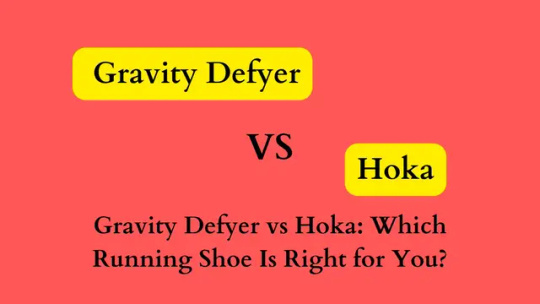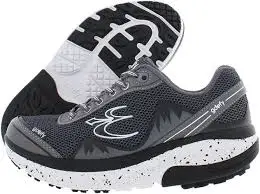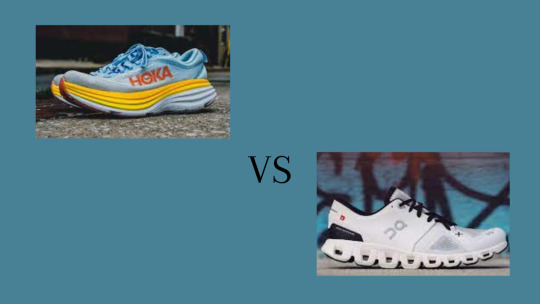#hokavsoncloudwhichoneisbetter
Explore tagged Tumblr posts
Text
Gravity Defyer vs Hoka: Which Running Shoe Is Right for You? 2024

Let’s dive into a detailed comparison between Gravity Defyer vs Hoka running shoes. These two brands offer distinct features, so understanding their differences can help you make an informed choice.
Allbirds vs Cole Haan: Which Brand Offers the Best
Gravity Defyer

- Overview: Gravity Defyer was founded in 2008 by Alexander Elnekaveh. The company’s mission is to create athletic and casual shoes that reduce joint pain. - Key Technologies: - VersoShock Trampoline System: This innovative spring system built into the midsole absorbs impact and reduces stress on joints and muscles. - Cradled Insole Design: Provides customized arch support and metatarsal cushioning, helping alleviate foot pain and conditions like plantar fasciitis. - Rocker Sole Design: Encourages a natural gait and proper alignment during walking or running. - Durability: Average outsole durability. - Design & Style: May have a bulky look and is not very stylish. - Popularity: Gravity Defyer is a less popular niche brand. - Best Selling Model: G-Defy Mighty Walk Athletic Sneakers.
Hoka

- Overview: Hoka One One was founded in 2009 by Nicolas Mermoud and Jean-Luc Diard. Their signature feature is the super thick midsoles, providing maximum cushioning for runners. - Key Technologies: - Meta-Rocker Outsole: Encourages a natural gait cycle and smooth transition. - Roomy Toe Box: Allows feet to splay and relax over long distances. - Durability: Excellent outsole durability. - Design & Style: Iconic thick silhouette, but also stylish. - Popularity: Hoka is a very popular mainstream brand. - Best Selling Model: Bondi 8.
Which One Is Better?
- Comfort & Cushioning: - Hoka wins in this category with its pillow-like cushioning, especially over long distances. - Gravity Defyer provides stability, foot, and joint pain relief, making it suitable for those with common foot problems or conditions like plantar fasciitis. - Style & Popularity: - Hoka is more stylish and enjoys widespread popularity. - Gravity Defyer may not be as fashionable but excels in targeted relief and joint protection. - Final Thoughts: - Consider your specific needs and running style before choosing between the two brands. If you prioritize comfort and popularity, go for Hoka. If you need stability and pain relief, Gravity Defyer might be the better choice .
What are the pros and cons of each brand?
Let’s break down the pros and cons of both Gravity Defyer and Hoka running shoes: Gravity Defyer Pros: - Joint Pain Relief: Gravity Defyer shoes are designed to reduce joint pain and impact on your feet. The VersoShock Trampoline System absorbs shock, making them suitable for people with foot conditions like plantar fasciitis. - Stability: The cradled insole design provides good arch support, enhancing stability during movement. - Niche Appeal: If you’re looking for a specialized shoe brand that focuses on comfort and pain relief, Gravity Defyer caters to that niche. Cons: - Style: Gravity Defyer shoes tend to have a bulkier appearance, which may not appeal to those seeking a sleek or fashionable design. - Limited Popularity: The brand is less well-known compared to others in the market. Hoka Pros: - Maximum Cushioning: Hoka shoes are famous for their thick midsoles, offering exceptional cushioning. This makes them ideal for long-distance running. - Meta-Rocker Outsole: The unique outsole design encourages a smooth gait cycle, reducing fatigue during runs. - Roomy Toe Box: Hoka shoes provide ample space for your toes to splay, promoting comfort. Cons: - Thick Silhouette: Some people find the chunky appearance of Hoka shoes less appealing. - Less Support for Specific Conditions: While they offer great cushioning, Hoka shoes may not provide targeted relief for specific foot or joint issues. Conclusion - Hoka is generally recommended for most runners due to its popularity, comfort, and style. - Gravity Defyer is a good choice if you prioritize joint pain relief and stability.
What are the price ranges for both brands?
Let’s compare the price ranges for Gravity Defyer and Hoka running shoes: - Gravity Defyer: - The price range for Gravity Defyer shoes varies based on the model and features. Generally, they range from around ₹6,999 to ₹11,340. - Notable model: G-Defy XLR8 Run. - Hoka: - Hoka shoes offer a wide range of options, from budget-friendly lightweight trainers to premium pairs with advanced technology. - Prices start at under ₹1,000 and can go up to ₹19,999 or more. - Notable models: Carbon X 3, Clifton 8, and Zinal.
Frequently Asked Questions
frequently asked questions (FAQs) related to Gravity Defyer and Hoka running shoes: Q: Are Gravity Defyer shoes suitable for long-distance running? A: While Gravity Defyer shoes provide joint pain relief and stability, they may not be the best choice for long-distance running due to their bulkier design. Consider Hoka for longer runs. Q: What is the key technology behind Hoka shoes? A: Hoka shoes feature a Meta-Rocker Outsole, which encourages a natural gait cycle and smooth transitions during running. Q: Do Hoka shoes have a roomy toe box? A: Yes, Hoka shoes are known for their roomy toe box, allowing your toes to splay comfortably. Q: Which brand is more popular? A: Hoka is more popular and widely recognized in the running community. Q: How much do Gravity Defyer shoes cost? A: Gravity Defyer shoes typically range from around ₹6,999 to ₹11,340. Q: What is the best-selling model for Hoka? A: The Bondi 8 is one of Hoka’s best-selling models. Q: Can I find stylish options in Hoka shoes? A: Yes, Hoka offers stylish designs, especially if you prefer vibrant colors. Q: Which brand provides better cushioning? A: Hoka wins in the cushioning department with its maximum cushioned midsoles. In summary, Hoka tends to have a broader price range, catering to various budgets and preferences, while Gravity Defyer falls within a more specific range. Keep in mind your comfort needs, running style, and budget when making your choice! 🏃♂️🏃♀️ Remember, the ideal pair of running shoes depends on your individual preferences and requirements. Happy running! 🏃♂️🏃♀️ Read the full article
#besthokawalkingshoes#gravitydefyer#gravitydefyerreview#gravitydefyerreviews#gravitydefyershoereview#gravitydefyershoes#gravitydefyershoeslegit#gravitydefyershoesreviews#gravitydefyershoesscam#gravitydefyershoeswalmart#gravitydefyerwomen#gravitydefyers#hoka#hokashoesfornurses#hokavsoncloudwhichoneisbetter#hokavsoncloudshoes#isgravitydefyershoeslegit#isgravitydefyershoesscam
0 notes
Text
Hoka vs On Cloud: A Comparative Analysis of Maximalist Running Shoes

Introduction
When it comes to running shoes, the market is flooded with options. Two brands that have gained prominence in recent years are Hoka and On Cloud. Both offer innovative designs, plush cushioning, and a commitment to enhancing the running experience. But which one is right for you? Let’s dive into the details and compare these two contenders. Gravity Defyer vs Hoka: A Stride into Comfort and Performance
The Brands
Hoka - Founded: 2009 - Philosophy: Maximum cushioning without compromising speed - Signature Feature: Marshmallowy, high-stack midsoles - Target Audience: Long-distance runners, endurance athletes - Materials: High-quality EVA and PEBA foam On Cloud - Founded: 2010 - Philosophy: Lightweight, responsive ride with shock absorption - Signature Feature: “Cloud-Tec” system with hollow pods - Target Audience: Runners seeking a smooth, efficient stride - Materials: Innovative sole design with hollow pods
Key Differences
Midsole Cushioning - Hoka: Known for its marshmallowy, high-stack midsoles. Despite their bulky appearance, Hoka shoes are surprisingly lightweight and provide a comfortable, pillowy ride. The high stack may feel unusual initially, but it’s one of the comfiest experiences fresh out of the box. - On Cloud: Takes a different approach. Their midsoles are lightweight due to the “Cloud-Tec” system—hollow pods that compress during landing to absorb shock and then lock in place during liftoff for a rock-solid toe-off platform. Ride Experience - Hoka: If you crave maximum cushioning and arch support, Hoka is your go-to. The sensation is akin to floating on clouds, offering a luxurious running experience. - On Cloud: For those who value lightweight, responsive shoes, On Cloud delivers. Its unique sole efficiently absorbs shock, providing a smooth ride. Durability - Hoka: Known for using high-quality materials, Hoka shoes tend to be more long-lasting. - On Cloud: While lightweight, On Cloud shoes may not match Hoka’s durability due to their minimalist design.
Popular Models
Hoka - Hoka Clifton 9: A daily trainer with plush cushioning. - Hoka Bondi 8: Max-cushioned shoes for ultimate comfort. - Hoka Speedgoat 5: Trail shoes built for rugged terrain. On Cloud - On Cloudsurfer: Responsive daily trainers. - On Cloudrunner: Budget-friendly shoes with shock absorption. - On Cloudboom Echo 3: Race day shoes for speed demons.
Conclusion
In the Hoka vs. On Cloud showdown, it ultimately boils down to your preferences. If you want a cloud-like experience with maximum cushioning, Hoka is your choice. On the other hand, if you seek a lightweight, responsive ride, On Cloud has you covered. Whichever brand you choose, remember that both are pushing the boundaries of running shoe design, making every stride smoother and more enjoyable. So lace up, hit the pavement, and find your perfect match! 🏃♀️🏃♂️ Read the full article
#altravshoka#cloud5#cloud5shoes#cloudmonster#cloudmonsterreview#hokavsaltra#hokavsoncloudwhichoneisbetter#hokavsoncloudshoes#oncloud#oncloud5#oncloud5review#oncloud5vscloud#oncloud5vsoncloudx#oncloudmonster#oncloudmonstervscloudsurfer#oncloudnine#oncloudreview#oncloudshoes#oncloudx#oncloudxvsoncloud5#oncloudsurfervs#oncloudsurfervscloudmonster#oncloudsurfervshokaclifton9#qccloud
0 notes
Text
Gravity Defyer vs Hoka: A Stride into Comfort and Performance In 2024

When it comes to selecting the right running shoe, the debate often narrows down to two innovative brands: Gravity Defyer and Hoka. Both have carved out unique spaces in the athletic footwear market, but they cater to different needs and preferences. Let’s take a closer look at what sets these two apart and which might be the better fit for your feet.
Gravity Defyer vs Hoka: Which Running Shoe Brand is Better?
Cushioning and Support: The Comfort Debate Hoka has become synonymous with maximalist shoe designs, offering a plush cushioning system that’s a favorite among long-distance runners and trail enthusiasts. Their thick midsoles are engineered to absorb impact and provide a stable ride, making them a go-to choice for those who prioritize comfort during extended periods of wear. On the other hand, Gravity Defyer focuses on a sleek, lightweight design that doesn’t compromise on support. Their shoes are equipped with advanced shock absorption technology, which is particularly beneficial during high-impact activities. This makes Gravity Defyer an attractive option for athletes who require both agility and protection. Aesthetic and Build: The Style Factor The aesthetic appeal of a shoe can be just as important as its functional attributes. Gravity Defyer shoes boast a modern and streamlined look that appeals to runners who prefer a less bulky silhouette. Hoka, with its stacked appearance, offers a distinctive style that has gained a loyal following. The choice here is largely subjective and depends on personal taste. Performance on the Track: Stability vs. Speed When it comes to performance, the Gravity Defyer shoes have been noted for their superior shock absorption, which translates to excellent support and stability during runs 1. This can be a significant advantage for athletes engaged in sports that involve a lot of lateral movements or quick changes in direction. Hoka, while offering substantial cushioning, may not provide the same level of responsiveness as Gravity Defyer. However, the comfort and protection offered by Hoka’s cushioning are unmatched, making them ideal for runners who are prone to injuries or those recovering from one. The Verdict: Which One Should You Lace Up? Ultimately, the choice between Gravity Defyer and Hoka comes down to your individual needs and what you value most in a running shoe. If you’re looking for a shoe that combines a lightweight feel with robust support, Gravity Defyer might be the way to go. But if you’re after a shoe that offers maximum comfort and cushioning, especially over long distances, Hoka could be your perfect match. Both brands have their merits, and they serve different purposes for different types of runners. It’s always recommended to try on both and take them for a test run to see which brand aligns best with your running style and comfort preferences. After all, the best shoe is the one that feels right on your feet and supports your stride, mile after mile. Whether you’re a seasoned marathoner or a casual jogger, the importance of choosing the right shoe cannot be overstated. Gravity Defyer and Hoka offer compelling options, each with its own set of features that cater to various aspects of running. By understanding the nuances of each brand, you can make an informed decision that will benefit your performance and, most importantly, your health. Read the full article
#besthokashoesfornurses#gravitydefyer#gravitydefyerreview#gravitydefyerreviews#gravitydefyershoereview#gravitydefyershoes#gravitydefyerwomen#gravitydefyers#gravitydefyercom#gravitydefyerlegit#gravitydefyerscam#gravitydefyer.com#hoka#hokamostcomfortablesneakers#hokashoesfornurses#hokavsoncloudwhichoneisbetter#hokavsoncloudshoes#hokawomensshoesforplantarfasciitis
0 notes